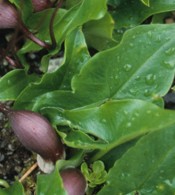 Mouse plant is a herbaceous perennial related to Jack in the Pulpit and is a native of Spain and Italy where it grows in shaded woodlands and marshy areas, It’s common name comes from the resemblance of its flowers to the hindquarters and tail of a mouse. The flowers are borne on a stem like structure (spadix) inside a purple and white hood-like structure (spathe) which gradually tapers to a long thin “tail” about six inches long . On the tip of the spadix is a tissue that looks like a fungus. It attracts fungus knats that enter the spathe through the opening in the tip of the “tail” to lay their eggs but pollinate the plant at the same time. The flowers usually lie out of sight below the green, arrow-shaped, six inch long leaves so placing the plant in an area where it is accessible is essential to enjoying it. The plants go dormant after flowering but make good companions for spring bulbs. Mouse plant spreads by rhizomes and slowly naturalizes.
Mouse plant is a herbaceous perennial related to Jack in the Pulpit and is a native of Spain and Italy where it grows in shaded woodlands and marshy areas, It’s common name comes from the resemblance of its flowers to the hindquarters and tail of a mouse. The flowers are borne on a stem like structure (spadix) inside a purple and white hood-like structure (spathe) which gradually tapers to a long thin “tail” about six inches long . On the tip of the spadix is a tissue that looks like a fungus. It attracts fungus knats that enter the spathe through the opening in the tip of the “tail” to lay their eggs but pollinate the plant at the same time. The flowers usually lie out of sight below the green, arrow-shaped, six inch long leaves so placing the plant in an area where it is accessible is essential to enjoying it. The plants go dormant after flowering but make good companions for spring bulbs. Mouse plant spreads by rhizomes and slowly naturalizes.
Type: Herbaceous perennial
Bloom: Purple and white spathe with 6” long taperd “tail” like encloses the flower bearing spadix in spring
Size:6” H x 12” W
Light: Part to full shade
Soil: Organic, moist, well-drained
Hardiness: Zones 7-9
Care: Plant 3.5 deep and mulch in winter
Pests and Diseases: None of significance
Propagation: Seed, division
Companion plants: Hosta, astilbe, Bergenia, ferns, bleeding heart, Epimedium, Anemone nemorosa.
